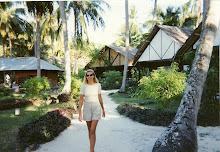I've mentioned before that one of the great things about living in Provence is that the region is so varied. From the Cote d'Azur and the dazzling Med to the wild Camargue, from the villages perchés of the Luberon and Vaucluse to the rugged Alpilles, and from the laid-back city of Avignon to the chic streets of Aix the region is practically spinning with variety.
But the other aspect of living here is the easy reach you have to other areas, regions and countries - to Italy and Spain, to the Aveyron, the Drome and the Languedoc.
I spent last weekend at Frontignan on the Languedoc coast in a little wooden cabin belonging to friends from Le Thor. They spend August there every year while their main home is rented to Parisians but we all go to Frontignan several times a year for weekends as well. The cabin, one of a kind on the shoreline and just a few paces from the sea, is classé by now I would think. It's surrounded by overgrown and elegantly drooping oliviers de Bohème
. The front of the structure is open wooden lattice-work, criss-crossed and with a tropical feel. Friends from Avignon added a wonky wooden-slatted terrace years ago where we eat outside. At the side of the cabin is an outdoor shower.
It's not chic but it's charming - one of the most relaxing places I know. Although Frontignan plage is stuffed with campsites and can be noisy in August, filled with families on holiday from Montpellier, the cabin is a little oasis of calm and greenery. Frontignan town is quite pretty too, with a nice little bar where you can eat and drink in the square outside the Mairie.
This late-May weekend we opened the cabin up for the summer, sweeping away the olive tree leaves that have fallen and drifted inside along with a little sand from the beach. There were cobwebs everywhere on a Hollywood horror-film scale, drifting from skylights, festooned across doorways. You'd think no-one had been in the place for a decade but we were all there just 8 months ago, when it was warm enough to swim in the Mediterranean in late September.
It took hardly any time though to clear up, and the weekend began.
One of the wonderful things about visiting the area is looking around the interesting town of Sète. Another is visiting the Etang de Thau to eat wonderful (breathtakingly inexpensive)Bouzigues oysters sur place.
Sète is right on the sea and still very much a port and fishing town. It's poor and feels very sinewy. You have these images in your head as you walk round, of muscular arms hauling at ropes on trawlers. Not of tall, broad fishermen but of short, wiry men, strong and used to sailing in the Med.
There's a wonderful open air concert venue high on the hill where you can see opera or hear jazz with the Mediterranean as a glamorous backdrop to the stage.
All through the summer, Sète stages a huge number of concerts and music festivals, well worth going to.
And there's an unmissable fish market in Les Halles. I'd feel deprived if I went to Sète without going to the fish market. It's largely a local affair with fisherman selling straight from their nets - direct du bateau. There's a thrilling mix of rough-and-ready and refinement in the market. The many stands are highly individual - colourful, painted with pictures of jaunty fish or sturdy boats. The names are French, Italian, Spanish - Raphael, Mario, Julien - reflecting geography and centuries of immigration. Stalls practically overflow with rougets, merlu, loup de mer, daurade royale, crevettes, palourdes, limandes, violets, tuna, oysters, mussels, lobster, squid. There are mixes for fish soup, heaps of whitebait, huge halves of swordfish, crabs, sea snails, sea urchins...
Signs announce where produce is "Fished locally", "From the Mediterranée." Trade is brisk, as they say, and there are long discussions about preparing different fish. Bouzigues oysters are sold in their 3 different sizes for as little as 7 euros a dozen.
Around Les Halles there are bars serving shellfish and chilled glasses of the local white wine, Picpoul de Pinet. The bars are filled mostly with men, drinking and gossiping cheerfully.
There's far more than fish and seafood here. There's everything. Fruit and veg, cheeses, oils and vinegars, hams and saucisses, stalls selling exquisite jams and flavoured honey and lots of stalls selling freshly-made pasta.
To me, Sète is an unreconstructed and mostly unmodernised French fishing town with loads of character, very visibly formed by the sea. Temperamentally, it's a thousand miles from the Cote d'Azur even if it's actually not far from St Tropez. With its poor French community and struggling economy, Sète is a bit of a stronghold for the Front National but you get the feeling that reflects weariness and economic fear rather than aggression. This is a port after all that has boats to-ing and fro-ing from North Africa every day. The Sète economy needs its African links.
Thursday, May 26, 2011
From Provence to the Languedoc: Eating Oysters at Bouzigues
Subscribe to:
Post Comments (Atom)

Tak, Sète to najpiękniejsze miejsce do spokojnego letniego odpoczynku,zwłaszcza, że ma przepiękną piaszczystą plażę, która ciągnie się kilometrami aż do Marseillan. Pozdrawiam Cię i pozdrów ode mnie Sète!
ReplyDeleteThanks for that. It translates roughly as: "Yes, Sète is a beautiful place for a quiet, restful summer, especially since it has a beautiful sandy beach, stretching for miles up to Marseillan Greeings to you and Sète!" I know that because I had a Polish boyfriend at university. Oh all right then, I ran it through Google Traduction.
ReplyDelete